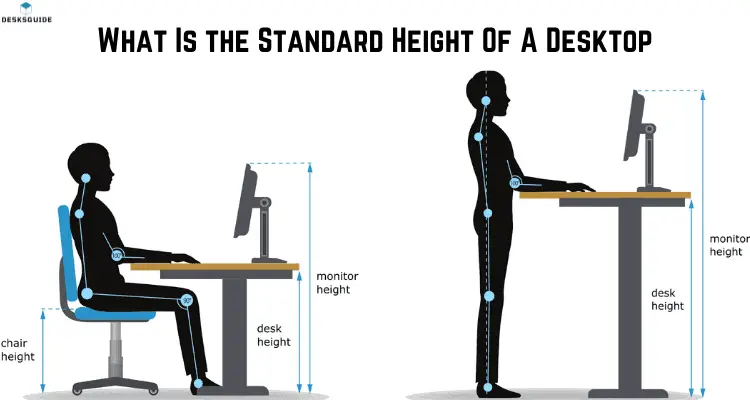I know you have made up your mind about buying a standing desk but you are curious to know
“Is standing desk good for your back ?”. Well, the answer is yes! A standing desk can help improve posture and reduce neck strain. They also allow you to move around while working, providing greater comfort and lessening the chances of developing back pain.
Table of Contents
Before diving in, let’s take a look at how sitting all day is bad for your back and how standing desks can help alleviate back pain and poor posture. Plus, we’ll answer some common questions about standing desks.
Is Standing Desk Good for Your Back?
Top 05 Reasons
Yes, a standing desk is good for your back but not the only solution for serious back issues. The key is to be active and keep changing positions throughout the day – sitting, standing, walking, or stretching. There’s no doubt that adjustable stand-up desks fix many of the problems associated with long sitting hours, but other solutions can also help.

1. Positive Effects on Health
Standing desks have been shown to reduce lower back pain and improve overall body posture, making them great for people who suffer from back problems or want to prevent other health-related issues. Additionally, sit stand desk can help boost energy levels, improve focus and concentration, and even burn more calories than sitting for too long.While standing, many back muscles and joints are used, encouraging them to stay flexible and strong. Ultimately, this helps to reduce the risk of potential long-term issues. Letting the body stand and stretch while working also increases blood flow to the brain, which helps to keep the mind alert.
2. Less Back Pain
When you stand, your spine is in its natural position, which helps to decrease back pain. However, sitting for long periods of time can lead to misalignment of the spine, which can cause pain and fatigue. Standing desks help to correct this, reducing back pain and discomfort due to prolonged sitting.It’s just a matter of maintaining good posture while standing and using an anti-fatigue mat to relieve the strain on your legs and feet. Also, wear supportive shoes and make sure to maintain a balance between sitting and standing while standing at a desk.
3. Higher Level of Productivity
Standing desks not only improve your physical health, but they can also help to improve mental well-being and productivity. Research has shown that standing for just one hour can help to increase productivity and reduce fatigue. Once you get used to it, you’ll find that you can work longer and more efficiently while standing.
Variations in posture also break up the monotony of sitting all day, which helps to keep your focus and motivation levels high. Your boss will appreciate it too!… And if you are the boss, you will see the benefits of standing desks for yourself.
We have a detailed research on how do standing desks help productivity, check it out.
4. Blood Circulation is Improved
Prolonged sitting can lead to poor blood circulation, which can cause clotting in the veins. However, standing desks help promote better circulation and allow you to move around more, improving the flow of oxygen to your muscles and brain.
CvgCares states, “Standing for at least two hours a day increases circulation, blood flow, and reduces blood clot risk. Using a standing desk prevents these negative effects of sitting.”
Obese people may also find standing desks beneficial as they help to improve their circulation and reduce the increased risk of varicose veins and vascular problems. More calories are burnt while standing, making it easier to maintain a healthy weight and avoid spinal disorders.
5. Increased Mobility & More Movement
Unlike sitting down all day, spending more time standing upright encourages you to move around more and makes it easier to transition between tasks. On the other hand, your body is not stuck in one position for too long, which can lead to stiffness, fatigue, and a decrease in productivity.
Standing desks allow you to move around, stretch your legs and even change positions throughout the day. This helps improve your mood and energy levels and your physical health.
So as you can see, there are many benefits to using a stand-up desk for your back. No matter what type of desk job you have or the level of physical activity you engage in, using a standing desk can improve your health and well-being.
So why not make the switch today? Well, wait and read more to find out how to use a standing desk optimally.
How Sitting All Day is Bad for the Back?
Sitting in the same position for too long can cause tension and strain on your back, neck, and shoulders. Sitting too often can also lead to chronic aches, pains, and even long-term damage to the back muscles and spinal discs.

According to MayoClinic, “The effects of too much sitting can include obesity and metabolic syndrome, leading to high blood pressure, as well as excess body fat around the waist, which can increase the risk of cardiovascular disease.”
I remember when I used to work from the office, I was sitting for 8 hours a day, and it took a toll on my back. That’s when I started researching standing desks and how they can help improve my posture. And then I’m here to share my experience with you.
How to Use Standing Desks for Alleviating Back Pain?
Knowing benefits will not be enough to alleviate your back pain, you need to follow a certain protocol for using standing desks optimally. I will be sharing three most essential points that you need to implement to reduce your back pain:
1. Make Sure your Desk is Adjusted Correctly

No matter how good the standing desk is, if it is not properly adjusted to your height, you will suffer back and neck pain. Some key factors to consider while adjusting your desk are:-
- The computer Monitor should be set at eye level, so adjust your desk height according to it.
- It’s best to keep the mouse and keyboard straight ahead at arm’s length from each other.
- Keep your feet flat on the ground while standing.
- Invest in an anti-fatigue mat and good arch-support shoes if possible.
Make these four adjustments, and you can reduce your back pain significantly. In addition, if you are working in a shared office with other co-workers, help them adjust their desks properly.
In order to ascertain correct desktop height as per your own height, then check out detailed guide with height chart here.
2. Alternate between Sitting and Standing
Standing for long hours can be just as bad for your back as sitting all day. Therefore, it is important to alternate between the two while working.
Standing for 15-20 minutes a day, then switching to sitting, will keep your posture good and break up the monotony of standing all day.
Even research tells that alternating between sitting and standing positions can reduce lower back pain and help in a productive workflow. Just make sure to keep an optimal balance, not only with sitting and standing but also with your diet, exercise, and sleep cycle.
One study even mentioned that the brain could generate 2.5 times new ideas when people alternate between sitting and standing.
3. The Best Way to Use a Standing Desk
The best way to use a standing desk is to set it up for the tasks you are about to do and then use it for a few minutes at a time. You don’t have to stand all day, but if you do, then take frequent movement breaks to change positions and move around.
Also, don’t forget to stretch and move around while standing, this will help you to stay energized and, at the same time, reduce your back pain from aggravating further in your body.
I will end the 3rd point by letting you know the best way to stand at your adjustable desk.
- Make sure your feet are firmly planted on the ground and your spine is upright. Relax your shoulders and keep your arms bent slightly at the elbows.
- Keep your head straight and maintain proper form while standing to avoid neck and back pain.
- It is also essential to avoid standing in the same position for a long time.
There are alot of advantages of standing desks, you can check it out here.
Video Recommendations: Is Standing Desk Good for Your Back?
Frequently Asked Questions (FAQs):
How long should you stand at a standing desk?
Depending on your individual situation, it is best to stand for 15–20 minutes out of every hour. Another best tip I can give you is to sit down immediately when you start feeling back pain or discomfort. When you sit, make sure to use a good office chair that provides adequate back support.
How much does a standing desk cost?
The price will vary depending on your chosen brand, the type of adjustable desk (whether manual or electric), and many other factors. If you are on a budget, I suggest you invest in standing desk converters which can be used on your existing regular desks. These converters cost much less than a full-standing and sitting desk and are very easy to use.
Does prolonged sitting cause back pain?
One of the major causes of back pain is prolonged sitting. Sitting for long hours puts a lot of pressure on the lower spine and neck muscles, leading to back aches, headaches, and fatigue. Therefore, taking frequent breaks and moving around while working is vital to reduce the risk of back pain.
Does standing desk help sciatica?
Standing desks are great ergonomic tools to help relieve the stress around the sciatic nerve roots in your lower back, legs, and buttocks. However, it is important to ensure that the standing desk is set up properly for you in order for it to be effective at relieving sciatica pain.
Final Verdict: Do Standing Desks Fix Back Pain?
As a final verdict, standing desks can be very beneficial for those suffering from back pain. With suitable adjustments and proper desk usage, it is possible to get relief from back pain. Just make sure you alternate between sitting and standing, keep your desk adequately adjusted according to your height, and take regular breaks to move around and stretch your body. With the right protocol, you will be able to reduce back pain significantly while reaping the benefits of standing desks. So go ahead and give it a try!
For more latest articles, visit Desksguide.com